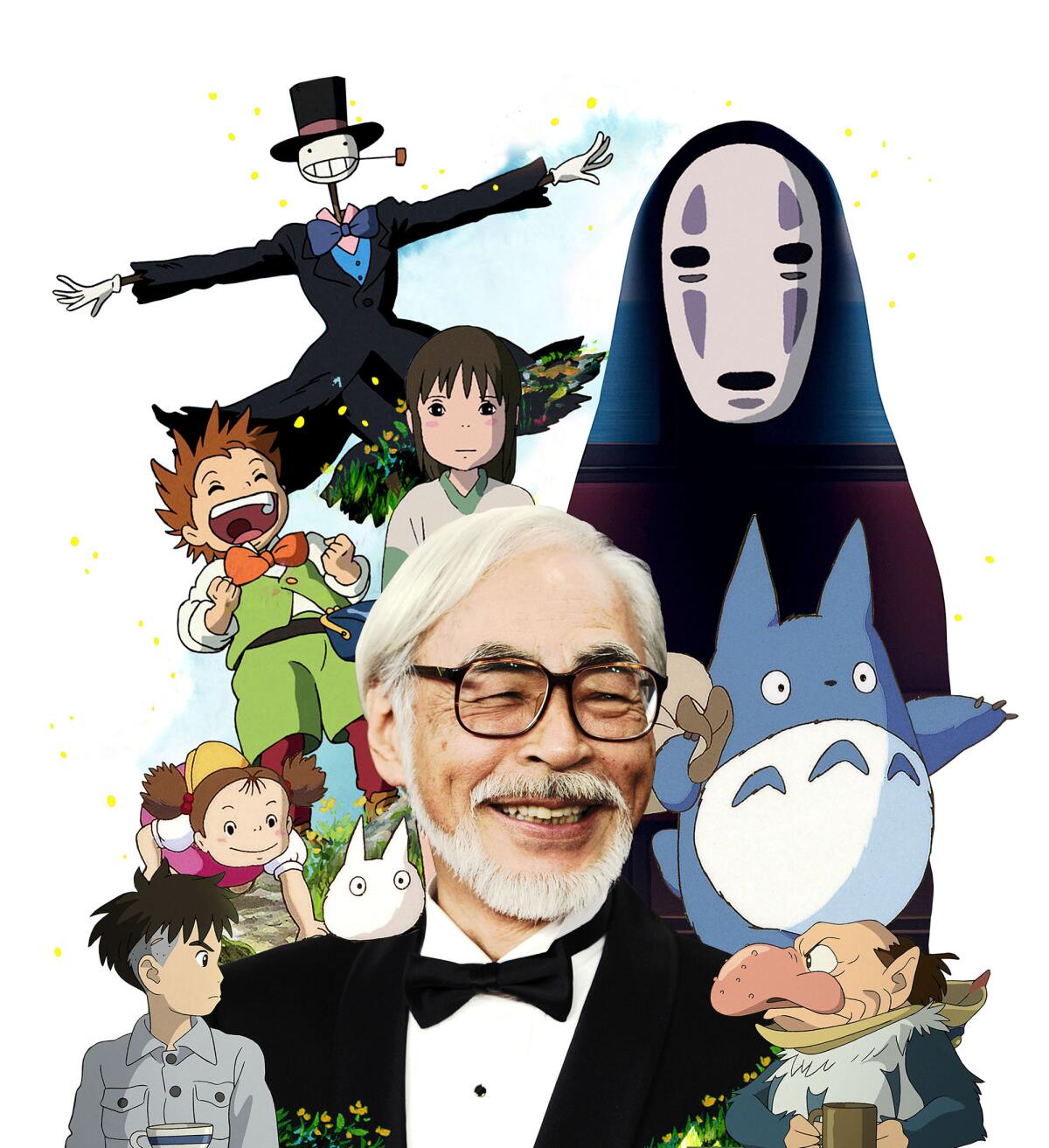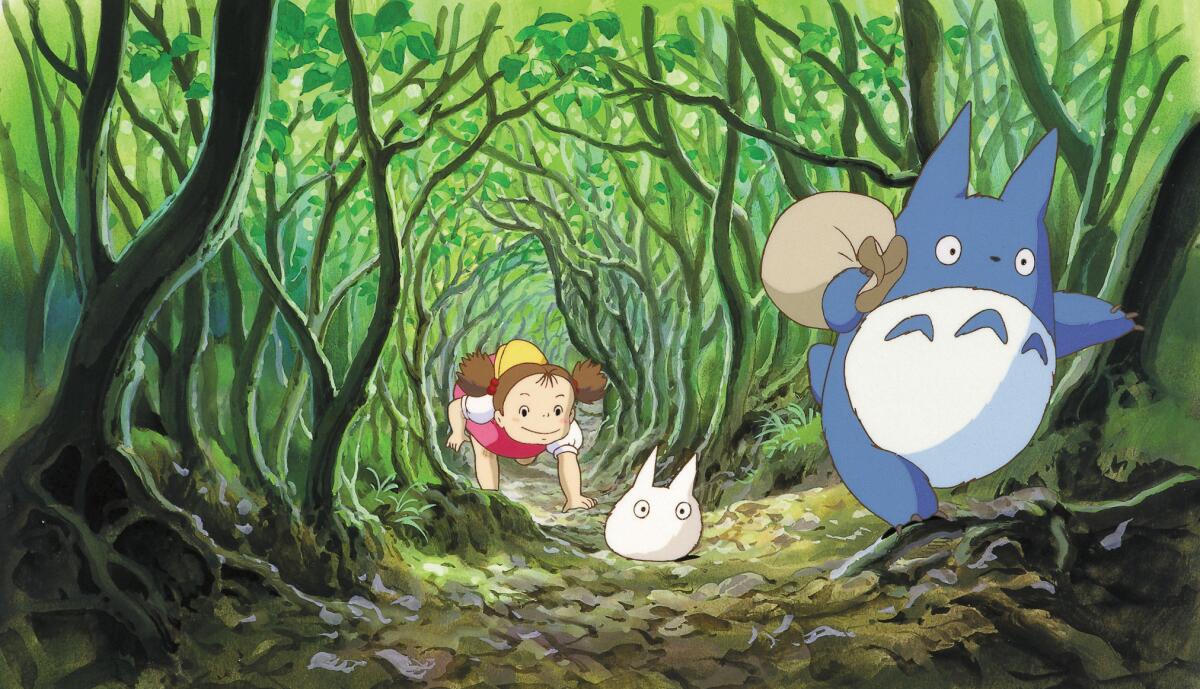Hayao Miyazaki’s ‘The Boy and the Heron’ makes clear the world is a fragile place

)
- Share via
When Hayao Miyazaki’s acclaimed new movie “The Boy and the Heron” made its North American premiere at the Toronto International Film Festival in September, one of the Japanese master’s biggest fans stepped on stage to introduce the long-awaited movie. “We are privileged enough to be living in a time where Mozart is composing symphonies,” said Oscar-winning filmmaker Guillermo del Toro. “Miyazaki san is a master of that stature, and we are so lucky to be here. He has changed the medium that he started in, revolutionized it, proved over and over again that it is a tremendous work of art.”
“Miyazaki, in my estimation, is the greatest director of animation ever, and he has made his films as full of dialogues and questions as he is,” continued Del Toro. “These are not easy films, but these are films that portray him so intimately, that you feel you’re having a conversation with him. And they are paradoxical because he understands that beauty cannot exist without horror, and delicacy cannot exist without brutality.”
Fans of the 82-year-old writer-director-animator and co-founder of Studio Ghibli are keenly aware of the magical powers of Miyazaki’s cinematic universe. Perhaps more than any other filmmaker alive today, he has been able to transport audiences to dreamlike worlds that have a distinctive, hand-crafted look and strange logic of their own. Yet, they speak to audiences all over the world because their main characters experience the full spectrum of emotions and experiences. The lead characters of the director’s 12 movies, which include the Oscar-winning “Spirited Away,” “My Neighbor Totoro” and “Princess Mononoke” stumble upon ethereal worlds and supernatural characters, but they are bound by human feelings of joy, love, fear and grief.
Starting as a dirge and ending as an ode to joy, “Never-Ending Man: Hayao Miyazaki” provides a privileged glimpse into the creative processes of one of the greatest animators who ever lived.
It’s a testament to the enduring appeal of the filmmaker that his new movie broke box-office records in Japan with little advance marketing or publicity ahead of its July release date. (As of early this month, the film has made over $63.5 million worldwide). The only clues potential audiences had about the film was a poster featuring the film’s very odd titular bird and the fact that its original title, “How Do You Live?,” was taken from a Genzaburō Yoshino book about a 15-year-old boy who has to learn about survival in a world consumed by death, war and sadness.
Echoing some of the themes and plotlines from Miyazaki’s oeuvre, the movie centers on a young Mahito, who encounters magical creatures and talking animals in a surreal world — like a cross between Lewis Carroll’s “Alice in Wonderland” and Ingmar Bergman’s “Fanny and Alexander.” The boy, who has lost his mother in a hospital fire in Tokyo, has a tough time adjusting to life with his father’s new wife — his mother’s younger sister — and their new home in the countryside.
Then, there’s the strange gray heron who badgers him and claims that his mother is still alive, and the mysterious tower built by Mahito’s long-vanished granduncle. This is all before our young hero enters the alternate world of the Tower, where he encounters menacing man-eating parakeets, younger versions of some of the characters from his real life, and cute bubble-like souls called the Warawara, who have to float to the surface to be born in Mahito’s world.

As Del Toro noted in a recent interview, “Miyazaki proves again and again that his films are not about leaving you chirpy: It’s about showing you the sweetness and sourness of life— the loss, the love and the beauty all at the same time. Hitchcock said repetition with consciousness is style: Miyazaki is saying, ‘I didn’t get it quite right in that movie. Let me get it right on this one.’ Rhythmically, he is very contemplative. This is an old master who has dispensed with tools and flourishes. They stop trying to impress. They offer a simple and beautiful gesture with a brush.”
Indie distributor GKIDS, which handles Studio Ghibli titles in the U.S., will release the movie on Dec. 8, following special preview engagements in New York and Los Angeles next week. The English-language voice cast includes Florence Pugh, Christian Bale, Dave Bautista, Gemma Chan, Mark Hamill, Karen Fukuhara, Willem Dafoe and Luca Padovan.
“I first saw ‘The Boy and the Heron’ at Studio Ghibli earlier this year, and after five minutes I began to cry,” recalls Eric Beckman, founder of GKIDS and L.A.’s Animation Is Film Festival. “There was another Miyazaki film in the world. What a gift. After ‘Totoro,’ ‘Spirited Away,’ ‘Princess Mononoke’ and ‘Howl’s Moving Castle,’ it’s easy to take for granted how unique Miyazaki’s gifts are. The beauty, the lusciousness, the humor and playfulness, the nuance are all here ... the movement of the heron in flight, of fish in the water, the tottering old aunties. Nothing can compare.”
HBO Max launched with all but one Studio Ghibli movie in its library. This is the best order to watch them.
Beckman agrees with many critics who have pointed out that “The Boy and the Heron” is Miyazaki’s most personal film by far. “In this movie, we have a great creator struggling to express something profound and important about life itself — both what to say and how to say it,” he says. “If ‘Totoro’ embodied a basic optimism — a celebration of the power and miraculous wonder of nature, a trust in nature — after 35 years, ‘Heron’ is not so optimistic about the state of the world anymore. This is not a kids’ cartoon or an episode in a superhero franchise. It is a work of cinematic art made by one of our greatest living filmmakers. Miyazaki is saying that the world is a fragile place, it may only last another day. What is the next step forward? That is up to the viewer to decide.”
In 2021, Miyazaki himself told the New York Times that he has a simple goal in mind whenever he sets out to make a new movie. “The mission of my films is to comfort you — to fill in the gap that might be in your heart or your everyday life.” When he was asked about the answer to the Japanese title of his movie “How Do You Live?” Miyazaki san responded, “I am making this movie because I do not have the answer.”
He might not have provided us with an easy answer, but he has once again managed to fill our hearts with the same sense of wonder we felt the first time we entered one of his remarkable realms.
More to Read
From the Oscars to the Emmys.
Get the Envelope newsletter for exclusive awards season coverage, behind-the-scenes stories from the Envelope podcast and columnist Glenn Whipp’s must-read analysis.
You may occasionally receive promotional content from the Los Angeles Times.






